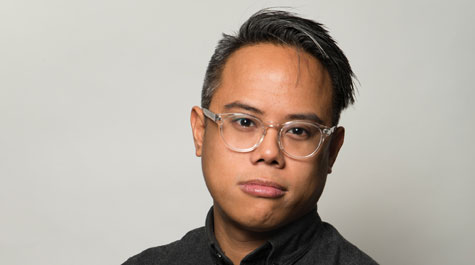Distinguished artist to commemorate W&M Asian Centennial
Roberto Jamora will be researching and then seeking to capture in imagery the history and experiences of Asian and Pacific Islander Americans at William & Mary.
Jamora will serve as distinguished fine arts fellow in residence for the university’s Asian Centennial during the upcoming academic year. Rinabeth Apostol in theatre and Marissa Aroy in film are also centennial arts fellows.
Jamora, whose parents emigrated from the Philippines in the 1970s, grew up in Virginia Beach. He teaches at Virginia Commonwealth University and William & Mary, along with exhibiting his paintings in numerous venues and private collections. W&M’s Muscarelle Museum of Art recently purchased one of Jamora’s works.
He will start off his efforts for the centennial doing research and has numerous art projects planned throughout the year, Jamora said. He will give several lectures and also will be expanding the design for the Asian-Pacific Islander-Middle Eastern Commencement stole that was done by a student group.
{{youtube:medium:right| zLREu928IFw, Roberto Jamora: Exploring art and expression in APIA}}
“I want to look at images in the archives of the university of Asian students over the years,” Jamora said. “Some of my interests are student organizing and the everyday lives and experiences of Asian students here at William & Mary.
“So that is going to be part of the process of the work that will inspire what the art projects look like. I’m working on four art projects.”
One of the first will be a large mixed-media piece using Jamora’s specialty, which is abstract painting dealing with color and how it invokes memory. Towards the end of the academic year, he is planning a self-portrait reflecting on his time at W&M and the things that he’s learned.
“I’m an educator and an artist, and I feel like both of those are integral to my identity, not just as a professional but personally,” Jamora said. “I believe that to be a good educator you have to be good learner.
“So I’m just really here being open to learning.”
Jamora also will work on a couple of print editions. He will be in residence at the Muscarelle in late September, partnering with Director of Engagement Steve Prince to pull an edition of prints for the museum.
“I’m going to be using the silk screen process, which is the same process that you use to print images on T-shirts; the same process that Andy Warhol used to create all those images using found photos,” Jamora said. “But I do it a different way, which will be exciting so I don’t want to give too much away.”
Jamora’s background informs his body of work in various ways, he said.
“I feel like that experience of diaspora, of distance, that’s kind of embedded in the experience of many Filipino people as a result of migration is definitely in the work,” he said.
“And when you look at my paintings specifically, you see a lot of color and you see these incisions on the canvas where the color is … the way that I mix the color, I’m trying to remind somebody of something but not exactly paint a picture.”
All kinds of signifiers of space are there, such as things getting lighter and softer as they fade into the background.
“In a lot of migrants’ experience, there’s this ethereality of home, something that’s so personal and intense but also out of reach a lot of the time,” Jamora said. “So for me, I’m always trying to think of how I can make abstraction and color extremely significant. But also welcoming the viewer to enter the work and think about the roles of color in their own personal experiences.
“What you’ll see on my canvases oftentimes if they remind you of a skin tone, that’s because I’m thinking about somebody. There’s this almost allusion to portraiture and figure painting without painting a picture.”















